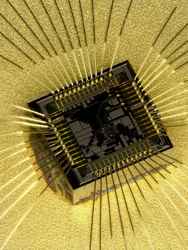
Posted to News on 12th Nov 2013, 09:59
Advanced research in microelectronics with the VHX
Keyence's VHX-1000 digital microscope allows French researchers to observe surfaces at 1000× magnification, capture images as large as 100 megapixels, and share these images all with very little effort.

The Montpellier Laboratory of Computer Science, Robotics, and Microelectronics (LIRMM) is a joint research unit of the University of Montpellier 2 (UM2) and France's National Centre for Scientific Research (CNRS). It conducts research in the field of sciences and technologies for information, communication and systems. The applications are varied and include medicine, with the implantation of ASICs to compensate for neurological disorders or paralysis (functional electrical stimulation).
The objective of LIRMM's Microelectronics Department (MIC) is to propose innovative solutions that have a genuinely disruptive impact on current approaches. The MIC Department's operations range from the design to the testing of low-end integrated systems (electrical and/or transistors) to high-end integrated systems (architectures, systems). The MIC Department also conducts research on adaptive architectures - microprocessor systems interconnected by redundant networks for fault tolerance purposes - as well as cross-cutting issues such as digital security, reliability and resilience.
Laurent de Knyff of LIRMM's MIC Department explains: "We work with companies on prototypes and manufacturing processes that are not always stable. Failures are common and our job is to analyse every potential cause of these failures, such as poor traces and connections and the presence of dust. These highly detailed observations require a high level of magnification and high image quality."
Generally, the chips used by LIRMM measure 2-3mm in size and are made using 65nm technology, meaning that the gate of the MOS transistor (a basic building block of microelectronics) measures 65nm long.
Mr de Knyff adds: "The VHX digital microscope suits our accuracy needs perfectly. It captures extremely sharp, high-resolution images easily and quickly. We use a 100W VHZ lens, most often at 1000× magnification." The VHX features a 16-bit HDR function that uses 16 bits-per-pixel encoding and HDR (high dynamic range) technology to create sharp, perfectly exposed images (neither too bright nor too dark) regardless of the contrast of the target.
Image stitching function
Mr de Knyff continues: "One thing that we really like about the VHX is that it's a digital tool that runs like a PC. Its clear, simple menus are intuitive and enable us to create highly useful automated functions. We use the real-time on-screen measurements and particularly like the image stitching function, which allows us to create large images of ASICs in just a few dozen seconds regardless of the image size. We then archive these images for later analysis. Because ASICs are fragile and we want to limit their handling to a minimum, this is a major plus point."
The VHX-1000 produces panoramic images as large as 10,000 by 10,000 pixels, or 100 megapixels. That translates to a fiftyfold increase in the size of the high-magnification field of view (normal field of view: 1600 by 1200 pixels). This is made possible by a powerful ultra-fast automatic image stitching function (2D stitching). When the image stitching button is pressed, the stage shifts and images are captured and automatically spliced together in real time.
Mr de Knyff adds: "In addition, MEMS and certain other parts we analyse are not flat. The VHX supports automatic adjustments to achieve a large depth-of-field and produce sharp, high-quality images regardless of differences in depth."
Getting to grips with the microscope was very simple. Mr de Knyff says: "The half-day of training we received from one of Keyence's sales engineers was sufficient to allow us to start getting the images we needed. I'm sure that, after two hours of training, a six-year-old would be able to produce quality images with the microscope. The optical adjustments are a little more complex of course, but you shouldn't hesitate to use the VHX's automatic adjustments. They allow you to play with the lighting and other parameters."
Mr de Knyff concludes: "In addition to its efficiency for our scientific observations, the VHX allows us to capture clear images and share them with colleagues, industrial partners and the scientific community. Our old method was amateurish and consisted of taking pictures through the eyepiece of an old microscope. It was both time consuming and inconvenient and the images were not as good."
To learn more about the VHX-1000 digital microscope from Keyence, please visit www.keyence.co.uk/PRIM6.
Want the latest machine building news straight to your inbox? Become a MachineBuilding member for free today >>















